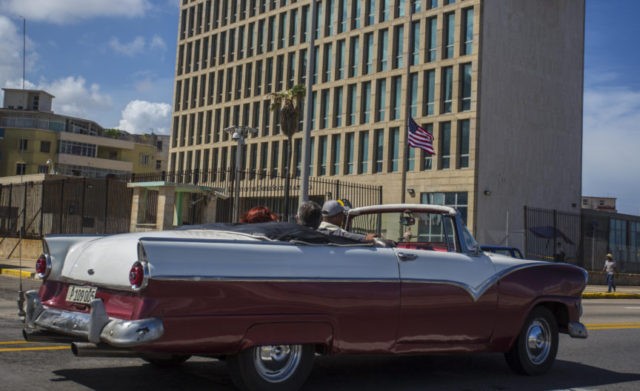Scientists observing the available evidence surrounding medical phenomena that injured American diplomats in Havana, Cuba, and a private American citizen in Shanghai, China, posited in interviews this weekend that the “concussion-like” damage could be the product of a microwave weapon.
The hypothesis has triggered speculation and skepticism in the scientific community, as some suggest microwaves could cause the sort of harm diagnosed in the more than two dozen Americans evacuated from Havana while also making the victims believe they are hearing high-pitched noises, which the victims did claim to hear. Those who doubt the theory note that a dish emitting microwaves would be too obvious of a weapon to place near a target to hurt them without them knowing, or suggest that the entire incident is a case of mass psychosis.
A study published in the Journal of the American Medical Association (JAMA) in February found that it would be impossible for those affected to have induced the brain damage discovered through paranoia or some form of mass psychosis, suggesting instead that a “novel mechanism” was used to hurt the individuals involved.
The Cuban communist regime initially denied any involvement in the attacks, then called the claims “science fiction,” before publishing an “official” study that found the victims had heard cricket noises and fabricated their symptoms. The incident in China occurred more recently and less information about it is publicly available, though the State Department has described it as consistent with the observations in Cuba.
Speaking to the New York Times in a report published Saturday, Douglas H. Smith, the lead author of the JAMA study, said that microwave radiation is a top suspect in the kind of exposure that could have resulted in the damage diagnosed in the patients in Cuba.
“Everybody was relatively skeptical at first and everyone now agrees there’s something there,” he told the Times.
“Strikes with microwaves, some experts now argue, more plausibly explain reports of painful sounds, ills and traumas than do other possible culprits — sonic attacks, viral infections and contagious anxiety,” the newspaper notes, adding that some scientists believe that the reason that the victims insisted they heard bizarre, shrill noises in their homes or hotel rooms before suffering dizziness, severe headaches, hearing and memory loss, and other symptoms is that microwaves can “trick” the brain into identifying them as sound waves.
Smith spoke to CNN on Sunday, elaborating on his comments to the Times.
“It’s almost like a concussion, but without a concussion — meaning that they look like individuals who have persistent concussion symptoms but have no history of head impact,” Smith said of the patients. “Just like we have ways to prevent people from having a concussion, you could think of maybe protecting your brain from these energy sources.”
Allan H. Frey, the scientist for whom this “Frey effect” is named after, told the New York Times he believes microwaves could also explain the attacks.
Multiple academic papers have since been published or are in the process of being published arguing that microwaves are the solution to the “sonic attack” mystery. Frey speculated that the Russian government could be behind such an attack, which the New York Times repeatedly focused on throughout the piece.
There is no evidence of any such attacks occurring against Americans in Russia, however, and the accusation against Moscow does not account for the incident in Shanghai. Blaming Russia also discounts that the Castro regime keeps close contacts with most of the world’s most violent rogue regimes, including China, North Korea, Syria, Iran, and Venezuela.
Yet the fact that scientists have identified at least one existing technology that could cause this damage contradicts much of the initial coverage of the incidents in both Cuban and left-wing American media. As the Cuban-American outlet Babalú Blog notes, “in response to claims the American diplomats in Cuba were victims of some sort of ‘sonic attack,’ the media, academia, and the ‘experts’ insisted no such technology exists. Well, apparently it does.”
While the technology exists, the microwave theory disregards two major keys of evidence that surfaced in the media but do not yet have confirmation from the State Department. The name “sonic attack” for the incidents was a product of reports that the State Department refused to confirm, citing medical record privacy, that the victims had heard shrill noises in their apartment. In response to Washington not confirming the reports, in October the Associated Press published what it claimed to be a recording of the noise that the diplomats heard, taken by one of the victims in Cuba. If a microwave weapon created the false noise, even if a human ear picked it up as a sound wave, the fact that it was not, in fact, sound could potentially prevent a machine from recording it.
Survivors of torture in Cuban prisons also questioned many concerns from skeptics that the Cuban communist regime was not capable of creating such technology – some noted that, during their torture as political prisoners, they were forced to listen to a large speaker play shrill noises similar to the one published by the AP for hours at a time, driving some to insanity and suicide.
Once again citing the need for privacy, the State Department has not issued a direct response to the new microwave hypothesis. The Cuban regime has also not made any public remarks about Smith’s remarks this weekend. Senator Jeff Flake (R-AZ), the most vocal defender of the Castro regime against accusations of attacks against diplomats in Cuba, has also not publicly responded to the studies.

COMMENTS
Please let us know if you're having issues with commenting.